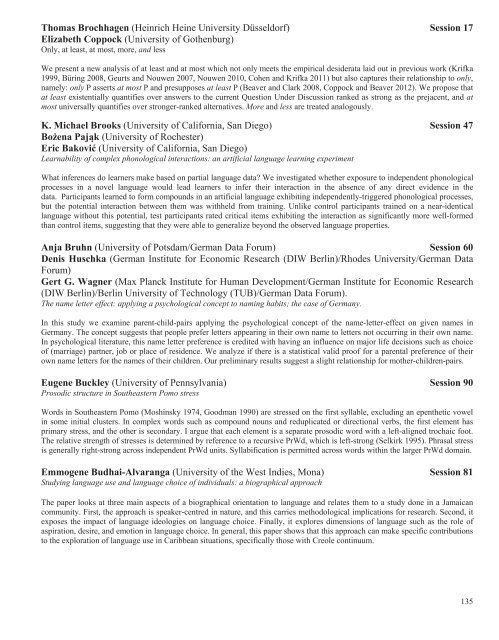here - Linguistic Society of America
here - Linguistic Society of America
here - Linguistic Society of America
Create successful ePaper yourself
Turn your PDF publications into a flip-book with our unique Google optimized e-Paper software.
Thomas Brochhagen (Heinrich Heine University Düsseldorf) Session 17Elizabeth Coppock (University <strong>of</strong> Gothenburg)Only, at least, at most, more, and lessWe present a new analysis <strong>of</strong> at least and at most which not only meets the empirical desiderata laid out in previous work (Krifka1999, Büring 2008, Geurts and Nouwen 2007, Nouwen 2010, Cohen and Krifka 2011) but also captures their relationship to only,namely: only P asserts at most P and presupposes at least P (Beaver and Clark 2008, Coppock and Beaver 2012). We propose thatat least existentially quantifies over answers to the current Question Under Discussion ranked as strong as the prejacent, and atmost universally quantifies over stronger-ranked alternatives. More and less are treated analogously.K. Michael Brooks (University <strong>of</strong> California, San Diego) Session 47Bożena Pająk (University <strong>of</strong> Rochester)Eric Baković (University <strong>of</strong> California, San Diego)Learnability <strong>of</strong> complex phonological interactions: an artificial language learning experimentWhat inferences do learners make based on partial language data? We investigated whether exposure to independent phonologicalprocesses in a novel language would lead learners to infer their interaction in the absence <strong>of</strong> any direct evidence in thedata. Participants learned to form compounds in an artificial language exhibiting independently-triggered phonological processes,but the potential interaction between them was withheld from training. Unlike control participants trained on a near-identicallanguage without this potential, test participants rated critical items exhibiting the interaction as significantly more well-formedthan control items, suggesting that they were able to generalize beyond the observed language properties.Anja Bruhn (University <strong>of</strong> Potsdam/German Data Forum) Session 60Denis Huschka (German Institute for Economic Research (DIW Berlin)/Rhodes University/German DataForum)Gert G. Wagner (Max Planck Institute for Human Development/German Institute for Economic Research(DIW Berlin)/Berlin University <strong>of</strong> Technology (TUB)/German Data Forum).The name letter effect: applying a psychological concept to naming habits; the case <strong>of</strong> Germany.In this study we examine parent-child-pairs applying the psychological concept <strong>of</strong> the name-letter-effect on given names inGermany. The concept suggests that people prefer letters appearing in their own name to letters not occurring in their own name.In psychological literature, this name letter preference is credited with having an influence on major life decisions such as choice<strong>of</strong> (marriage) partner, job or place <strong>of</strong> residence. We analyze if t<strong>here</strong> is a statistical valid pro<strong>of</strong> for a parental preference <strong>of</strong> theirown name letters for the names <strong>of</strong> their children. Our preliminary results suggest a slight relationship for mother-children-pairs.Eugene Buckley (University <strong>of</strong> Pennsylvania) Session 90Prosodic structure in Southeastern Pomo stressWords in Southeastern Pomo (Moshinsky 1974, Goodman 1990) are stressed on the first syllable, excluding an epenthetic vowelin some initial clusters. In complex words such as compound nouns and reduplicated or directional verbs, the first element hasprimary stress, and the other is secondary. I argue that each element is a separate prosodic word with a left-aligned trochaic foot.The relative strength <strong>of</strong> stresses is determined by reference to a recursive PrWd, which is left-strong (Selkirk 1995). Phrasal stressis generally right-strong across independent PrWd units. Syllabification is permitted across words within the larger PrWd domain.Emmogene Budhai-Alvaranga (University <strong>of</strong> the West Indies, Mona) Session 81Studying language use and language choice <strong>of</strong> individuals: a biographical approachThe paper looks at three main aspects <strong>of</strong> a biographical orientation to language and relates them to a study done in a Jamaicancommunity. First, the approach is speaker-centred in nature, and this carries methodological implications for research. Second, itexposes the impact <strong>of</strong> language ideologies on language choice. Finally, it explores dimensions <strong>of</strong> language such as the role <strong>of</strong>aspiration, desire, and emotion in language choice. In general, this paper shows that this approach can make specific contributionsto the exploration <strong>of</strong> language use in Caribbean situations, specifically those with Creole continuum.135
















